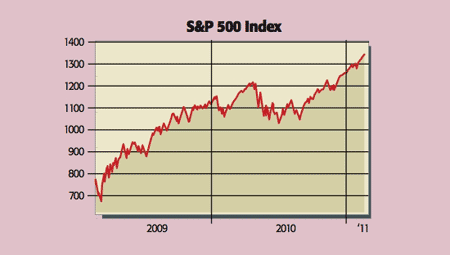Equities have produced an "incredible" rally since the March 2009 bottom, says David Rosenberg of Gluskin Sheff. European and British stocks have jumped back to levels last seen two and a half years ago. Meanwhile, America's S&P 500, which sets the tone for world markets, has doubled. Sentiment is as bullish as it gets. Last week, developed-market equity funds enjoyed their biggest inflow for 30 months, according to data provider EPFR.
Strong recent profits and macroeconomic data have continued to point to a strengthening global recovery. Potential problems, such as political unrest and higher oil prices, are taking a back seat. Yet investors assuming that the global economy is returning to normal are missing the bigger picture.
As James Mackintosh says in the FT, there is nothing normal about the economic backdrop. "Give a patient in intensive care enough pain killers, and she will feel fine; give her even more and she might get up and dance. Western economies are being numbed." Interest rates have never been this low they are at a 300-year low in Britain while the Fed continues to print money. That, says Buttonwood in The Economist, is a sign central banks "are still very worried about the fragility of the economy". Meanwhile, governments have tempered the impact of the credit bust by running up unprecedented deficits. Record stimulus, rather than healthy self-sustaining growth, is underpinning the rally.
MoneyWeek
Subscribe to MoneyWeek today and get your first six magazine issues absolutely FREE

Sign up to Money Morning
Don't miss the latest investment and personal finances news, market analysis, plus money-saving tips with our free twice-daily newsletter
Don't miss the latest investment and personal finances news, market analysis, plus money-saving tips with our free twice-daily newsletter

Yet valuations have been driven up to "official bubble territory", says Jeremy Grantham of fund managers GMO. The cyclically adjusted price-earnings ratio in America is at 24, far above the average of 16 seen during the past century or so. Indeed, 24 is the third-highest level in history. Another sign of irrational exuberance is that dividend yields are absurdly low, considering the US is subsisting on printed money, says FT Deutschland. The S&P's measly 1.7% yield is miles below the 4.8% average of 1871-1996. This is "frightening".
This rally looks even shakier than the huge bear market rally of 2003-2007, notes Rosenberg. That was based on "unsustainable credit and house-price growth". This one is due to "surreal public-sector intervention". Whether this bubble keeps inflating until the stimulus is withdrawn, or it meets a pin before then, stocks look worryingly susceptible to a nasty reversal.
A demographic headwind for stocks
The latest annual Equity-Gilt Study from Barclays Capital suggests that US share prices are set to struggle over the next few years as the population ages. Its analysis splits the population into three groups: 25 to 34-year-olds, 35 to 54-year-olds, and the over 65s. The middle group consists largely of savers who have money in equities. The young are mostly borrowers, while the over-65s are spenders running down their savings to finance retirement.

Equity returns are linked to the ratio of low to high savers (the young plus the old divided by the middle group). When this ratio declined from around 1.6 to 1.1 between the early 1980s and 2000, stocks did well. Baby boomers saving for retirement helped underpin strong returns from equities. Now the ratio is heading back up to levels last seen in the late 1970s. Baby boomers are retiring and the number of those saving into equities is falling. Last time it rose, from the mid-1960s to early 1980s, stocks disappointed. The model implies that real returns could henceforth be just 3% a year. That compares to an average of 6.7% a year over the past 85 years.
Get the latest financial news, insights and expert analysis from our award-winning MoneyWeek team, to help you understand what really matters when it comes to your finances.
MoneyWeek is written by a team of experienced and award-winning journalists, plus expert columnists. As well as daily digital news and features, MoneyWeek also publishes a weekly magazine, covering investing and personal finance. From share tips, pensions, gold to practical investment tips - we provide a round-up to help you make money and keep it.
-
 What do falling interest rates mean for you?
What do falling interest rates mean for you?You may think that only businesses and politicians should pay attention to choices made by the Bank of England, but its interest rates decisions also have an impact on your personal finances. We explain how.
-
 Halifax: UK house prices at lowest level since summer as growth slows
Halifax: UK house prices at lowest level since summer as growth slowsProperty prices fell by 0.6% month-on-month in a typical Christmas season slowdown, Halifax’s latest house price index shows.

